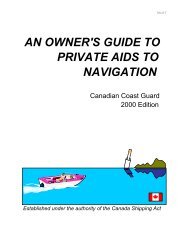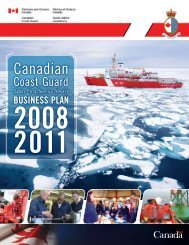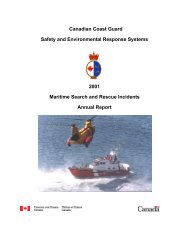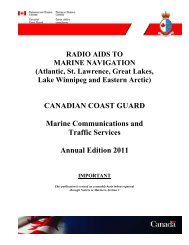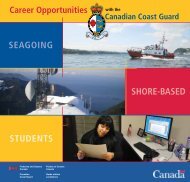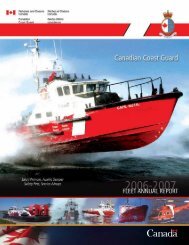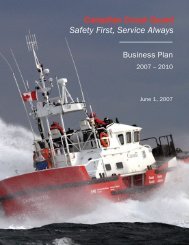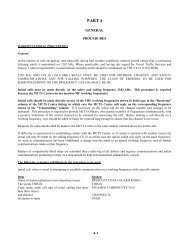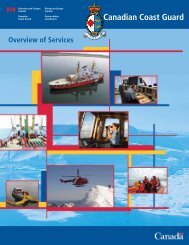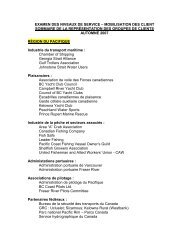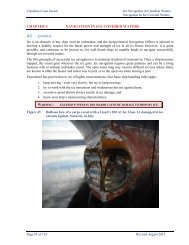Business Plan - Canadian Coast Guard
Business Plan - Canadian Coast Guard
Business Plan - Canadian Coast Guard
You also want an ePaper? Increase the reach of your titles
YUMPU automatically turns print PDFs into web optimized ePapers that Google loves.
FOCUS ON EFFICIENCY AND EFFECTIVENESSPriority 4: Modernization throughInnovation and Technology18It will always be a CCG priority to investigate andimplement new ways of doing business that allow usto realize greater efficiencies and bolster our resultsfor <strong>Canadian</strong>s.Aids to Navigation of the 21st CenturyLaunched in 2006-2007, the Aids to Navigation ofthe 21st Century (AToN21) initiative reaffirmed ourcommitment to innovation and continuous improvement,while maintaining our strong tradition of service andsafety. We made real progress on this front; in additionto our 2008-2009 accomplishments, we have reducedthe number of hard-copy Notices to Mariners by 33%since last year and finalized a report evaluating CCG’sexperience in contracting out aids to navigation. As partof the review of the aids to navigation systems, programpersonnel will continue to ensure that mariners’ needsare met, in light of the new2008-2009 AccomplishmentsAids to Navigation of the 21st Century• Completed the modernization of fiveadditional aids to navigation directives.• Developed National maintenancestandards for fixed and floating aids.e-Navigation• Initiated engagement with the shippingindustry on CCG’s vision, strategy, andnext steps on e-Navigation.technology and today’snavigation. At the same time,they will continue to look forthe best delivery options.On the technical andequipment side, theintroduction of plastic buoysand light emitting-diode(LED) lanterns is complete.The four-season lightedbuoys tested in the QuebecRegion on the St. Lawrence continue to show goodpotential. This four-season technology will continue tobe investigated and, once completed, will be shared withall regions for implementation where it makes sense andwhere it will meet mariners’ needs.The implementation of lifecycle management,national specifications, and standards has progressedsignificantly within the technical services community.It is now standard practice within CCG to considernew technologies in support of aids to navigation.In 2009-2010, a project close-out report will becompleted, highlighting successes of the AToN21 projectand discussing the challenges encountered. Many of theproject initiatives have now moved into daily operationsin the Aids to Navigation (ATN) program and haveset the stage for continuous improvement in ATNprogramming. Some initiatives (such as adjustmentto Loran-C) cannot be completed as initially envisagedbecause of developments external to CCG and willneed to be reconsidered. Finally, some initiatives, suchas e-Navigation, have matured to the point wherethey require dedicated work outside the AToN21project context.CommitmentLead2009-2010Complete the modernization of three additional AG DG, MSaids to navigation directives.Produce an AToN21 project close-out report. AG DG, MS2010-2011Complete the modernization of the six remainingaids to navigation directives.AG DG, MSe-NavigationIn 2008-2009, we initiated work in response to increaseddemands for e-Navigation services. e-Navigation is nota new type of equipment, but a concept that involvesa broad range of navigation systems and services.Technological advances, coupled with the success of pilotprojects, clearly demonstrate the potential and the needfor this service.What is e-Navigation?As defined by the International Maritime Organization (IMO),e-Navigation is:The harmonised collection, integration, exchange andpresentation of maritime information onboard and ashoreby electronic means to enhance berth-to-berth navigationand related services, for safety and security at sea andprotection of the marine environment.Implementing e-Navigation in a coordinated andorganized manner in Canada could significantly enhancesafety, have positive economic effects, and increaseenvironmental protection. If current technologicaladvances occur without proper planning, there is arisk that marine navigation systems of the future couldbe hampered by a lack of standardization (ashore andship-borne), incompatibility between vessels, and anunnecessary level of complexity.As the agency responsible for the delivery of maritimeservices, we are well positioned to play a leadership rolefor Canada. Integral to the success of e-Navigationwill be the ability to meet client demands, modernize<strong>Canadian</strong> <strong>Coast</strong> <strong>Guard</strong> — www.ccg-gcc.gc.ca



